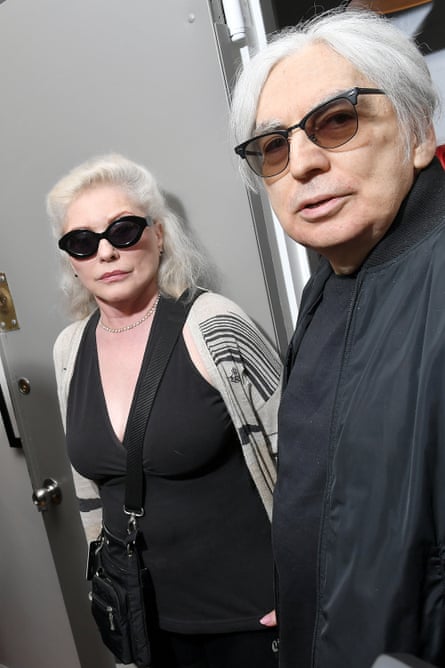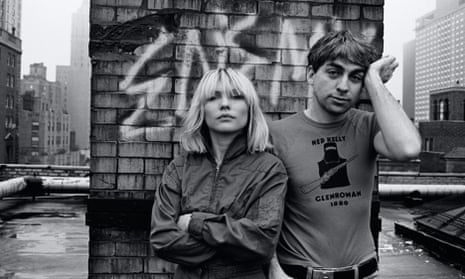When most people see a beat-up car abandoned on a street, they rubberneck for a second and move on. When Debbie Harry saw one lying upside down on a midtown Manhattan street in 1976, she thought, what a great place for a photo shoot! “It seemed really funny and glamorous to get a shot of me crawling from the wreckage,” said the Blondie singer as she gazed at the photo.
After all, what could be more punk than to repurpose a car wreck as your own personal jungle gym? Harry talked to the Guardian about that shot as she toured a new show of classic punk photos at the Morrison Hotel Gallery in New York’s Soho district. “When I look at these photos, I’m not seeing me,” she said. “I’m seeing the photos themselves. They’re very interesting and well-shot.”
The car photo, by Bob Gruen, doesn’t just capture an era. It nails a sensibility, one central to the New York of its day. Back in the mid-70s, local artists embraced the city’s chaos and decay both as an expression of unappreciated beauty and as a badge of honor. They reveled in everything that everyone who hated New York feared – the noise, the dirt, the crime. In early Blondie shows, Debbie often danced around with front pages from the New York Post, each of which sold sleaze as high camp. On-the-fly photos from the era can now be hawked as immortal art by galleries like Morrison Hotel. Prices here run between $500 and $4,000 per print. Early interest in the show ran high enough to inspire a line down Prince Street, peopled by ageing punks and younger invitees, awaiting entry into the inner sanctum. Inside, the gallery swelled with designers, hairdressers and rock’n’roll survivors, along with some of the photographers whose work enlivens its walls, including Gruen and Allen Tannenbaum, whose sooty photos of the era comprise the book New York in the 70s.

Chris Stein, who arrived with Harry, singled out a brazen image of the two of them from 1980. Like most of the shots here it’s black and white, capturing the us-against-them contrasts enjoyed by the original New York punks. Shot by Tannenbaum, the image captures Stein and Harry when they were a couple, on the roof of the building where they then lived on West 58th Street, eight blocks north of the car shot. “It was a fucking penthouse and we paid $500 a month for it,” Stein said.
For the photo, Stein got a can of white spray paint and scrawled the word “Enemy” on a wall behind them. It was a Sex Pistols-inspired act of revenge aimed at the NME, which planned to use the shot for an upcoming piece on the band. “They had done a story on us earlier and it was the first time we had a journalist be really nice to us and then kill us in print,” Stein recalled. “It was shocking at the time.”
Such tensions between the bands and the press typified a time when punks were often misunderstood, if not outright loathed. “Our whole relationship with radio in American was particularly weird,” Stein said. “Debbie did a radio tour at one point and people were really afraid of her. Those guys didn’t want to be in the same room with her. The whole image of punk was so severe.”
Mainstream audiences were no more accepting. “The Ramones went out on tour, opening for Edgar Winter, and I always pictured them under a pile of beer cans hurled by the crowd,” Stein said.

Though Blondie became one of the few early punk acts to break through, Harry retains a cool remove. With her thickly braided hair, now handsomely white, and her tight black dress, the 72-year-old star looked on this night like an uncommonly well-preserved gangster moll. Forty-four years after Blondie formed, they remain a thriving concern. Their tour last year, co-headlined by Garbage and titled the Rage and Rapture Tour, sold out scores of theaters, while their most recent album, Pollinator, made the UK top 10 and rose higher on the US charts than any Blondie release for two decades.
Harry is currently working on her memoir, which may or may not come out at the end of the year. Stein, 68, has his own book of photographs coming in the fall, titled Point of View. It follows a collection of photos he took, published in 2014 by Rizzoli under the title Chris Stein/Negative: Me, Blondie and the Advent of Punk. “The first book was more about the bands and the music,” Stein said. “This one is more street stuff, the ambience of the city of the period. Now the city is the antithesis of what it was. A gritty artists’ community is now stores that rent for $250,000 a month. And they don’t even do business.”
Working their way around the gallery, Stein and Harry spied young shots of peers like Talking Heads, Television and the Ramones. Spencer Drate, who designed the cover of the Ramones’ 1980 album End of the Century, which featured a cover shot by Mick Rock included in the show, said the band were not at all happy with the photo. “They had two shots from that session – one with them wearing leather jackets, and one without,” he said. “The record company made them use the one without the leather, to soften their image. The band hated it.”
Looking at all the images brought out a note of sadness in Harry. “It makes me miss all the people that are gone,” she said. “It’s hard, very hard.” That necrology list includes all four Ramones, Johnny Thunders, Jerry Nolan, Sid Vicious, Joe Strummer and more. “At the same time, it makes me grateful I’m here,” Harry said.
Later in the night, I asked both Harry and Stein what advice they would give to the younger selves that stared back at them from the photos. “Do whatever you want,’” she said.
“But don’t trust anybody,” he added.
Spoken like true punks.
